Physical Address
304 North Cardinal St.
Dorchester Center, MA 02124

(Continued from Page 3)
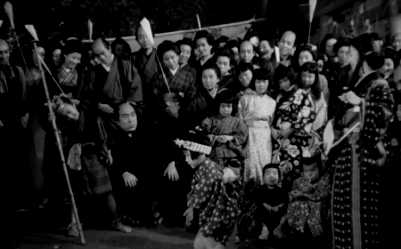
Although Uchida’s cinematic world, like that of Kurosawa, is very much one of men and their actions and conflicts, the director demonstrates here, as in later films, sensitivity and insight in his depictions of women. The two contrasting female characters in this movie are particularly fascinating. The shamisen player, Osumi, though poor, is never a victim, and she constantly teases her “superior,” Gonpachi. However, this woman likes Gonpachi and his essential good-heartedness; she just can’t resist the temptation to bring his ego down a peg. And part of the miracle of this movie is the way in which Uchida can explore, in the context of a period comedy, such complex relationships, which feel very modern, without any sense of anachronism.
The Otane subplot represents the first instance we’re aware of in Uchida’s extant work of prostitution as a major theme, which would become something of an obsession with him in the years to come. This theme is central to Chikamatsu’s Love in Osaka, Hero of the Red-Light District, and, in the context of modern Japan, A Fugitive from the Past.1 I suspect that sexual exploitation was for this director what it became for Godard in his later work: a metaphor for capitalist exploitation in general. But it clearly also has very strong personal resonance for him.
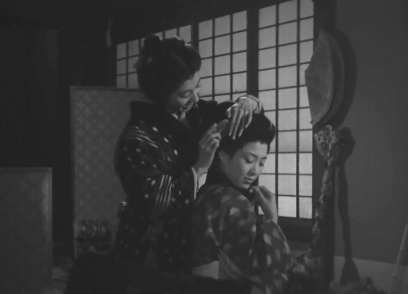
Otane, as portrayed by Tashiro Yuriko – a minor actress whose brief career ended with a small role in Ozu’s Late Autumn (Akibiyori, 1960) – seems as exquisite as the tea bowl that Kojūrō is transporting, and it makes perfect sense that this samurai, who loves beautiful things, would develop a platonic crush on her. It also makes sense that Osumi, like a lady-in-waiting to a princess, would patiently arrange Otane’s hair for her while commiserating with her fate.
Otane’s own reaction to that fate, though, is intriguingly ambiguous. At times she appears as passive as a child led unwillingly to school. But at other times, she reveals a streak of rebelliousness, as in the scene in which she reminds her father of the argument she had had with her mother prior to their departure from the village, which, according to her, turned “violent.” The nature of that violence is never spelled out, or even whether it involved more than harsh words, but it seems clear that it was the mother’s own idea that Otane be sold, a plan that the feeble old father apparently lacked the strength to resist: a disturbing instance of a woman complicit in her gender’s oppression.
The serene beauty of Otane is contrasted with the physical and moral ugliness of Kyubei the pimp, shrewdly played by Yoshida Yoshio. It seems very believable that when Tōzaburō accuses Kyubei of having killed his daughter, the bewildered old man, convinced of his innocence, blandly replies that the girl died of an illness. However, that sickness was very likely venereal disease, which devastated the courtesans of the Edo period. Only when the diligent officer of the law, Denji, confronts Kyubei does he seem to betray any shame in his profession. (It seems to me more than a bit contrived, though, that Uchida uses this benign lawman, who just happens to have overheard the whole exchange, as a kind of deus ex machina to resolve the situation.)
The point is that when Uchida criticizes the custom of poor or debt-ridden families selling their daughters into prostitution (or loveless marriages), he’s not condemning a barbaric practice of a distant, feudal age, but one that, though illegal, still existed in “democratic” Japan in the mid-1950s. The blogger for Japanonfilm points out that the sexual sale of a daughter was a key plot point in the contemporary film A Policeman’s Diary (Keisatsu nikki, by Hisamatsu Seiji), released in the very same year as A Bloody Spear at Mount Fuji: 1955.
I’ve talked about this movie so far in terms of its themes and characters, almost as if it were a novel. But Uchida was a great visual master, and these are three images from the film that stick in my mind as examples of his extraordinary panache as a film artist:
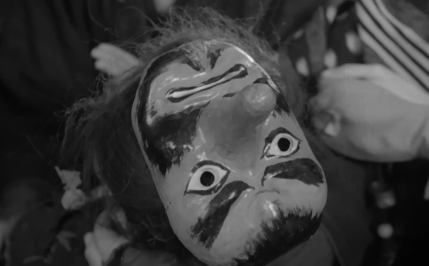
– When Jirō falls out of the tree and Gonpachi and Osumi rush to aid him, the boy’s fearsome-visaged demon mask is seen upside down, reflecting the injured little boy’s pain.
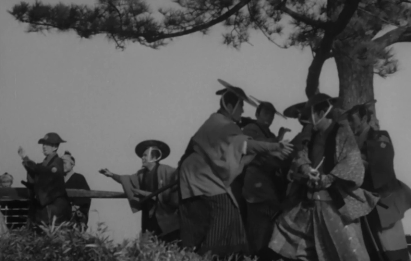
– When some aristocrats decide to stop by the side of the Tokaido highway to enjoy an open-air tea ceremony with a view of Mount Fuji, their retainers create a human roadblock, preventing anyone from passing in either direction. The common people grumble but accept this passively. But at that moment the entourage of another aristocrat approaches and demands to be let through. The nervous retainers on both sides are thus placed in conflict, with one side demanding to pass and the other absolutely determined to prevent it. The filmmaker observes from a distance, bemused, as these comical men in their peculiar costumes start a mini-war over their competing claims for ownership of the public road.
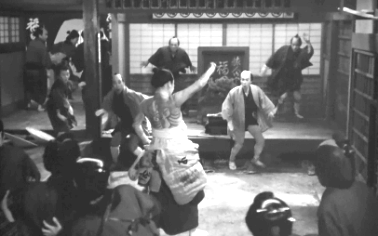
– Throughout the film, we’re told that the notorious thief, Rokuemon, can be identified by an enormous tattoo on his back. Then his cover as a Buddhist priest is exposed by Jirō and he is cornered. With miraculous suddenness, like a dream, Rokuemon is revealed as shirtless and tattooed, dagger in hand, transformed from a clownish fraud to a dangerous thug in a split second.
Despite – or perhaps because of – the fact that Uchida was attempting a comeback in a film industry now alien to him after more than a decade’s absence, he looked to the past for inspiration. Chief among his role models was the prewar filmmaker Yamanaka Sadao, the greatest prodigy in the history of Japanese Cinema.
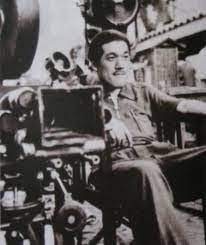
Yamanaka during his brief career had made period films exclusively. But his art was character-driven, and he had a knack for dramatizing situations that had great personal resonance for Depression-era audiences. Only three of his films survive today complete, but from just those three, we know that he was adept at the comedy of (period) manners, the action film and the proletarian tragedy.
One of the three screenwriters for Bloody Spear was Mimura Shintarō, who’d worked on scripts for all three extant Yamanaka films – Tange Sazen and the Pot Worth a Million Ryō (Tange Sazen yowa: Hyakuman ryō no tsubo, 1935), Priest of Darkness (Kōchiyama Sōshun, 1936) and the director’s masterpiece, Humanity and Paper Balloons (Ninjō kami fūsen, 1937) – as well as many others now lost to time. Yahiro Fuji had also written many films for Yamanaka (all lost), and had recently co-written the script for Mizoguchi’s great tragedy, Sansho the Bailiff (Sansho Dayū, 1954). Tamikado Toshio had scripted many period films since the 1930s. These three writers, along with, presumably, Uchida’s three advisors – Ozu, Shimizu and Itō – provided many cooks for the unique mixed-genre stew the director created.
In 1955, the Japanese film industry had only recently begun to make jidai-geki films in great numbers again, as the American Occupation – which never really understood the genre – had falsely assumed that such films invariably encouraged feudalism and nationalism, and thus banned almost all of them. (The Occupation had ended less than three years earlier, in late 1952.) Uchida therefore probably thought it commercially prudent to create a film that hearkened back to the kind of period movie that the older segment of the audience had enjoyed in its youth, but with a very up-to-date ironic spirit to appeal to younger viewers.
Though the narrative is beautifully controlled and developed, A Bloody Spear offered little stylistically that was, strictly speaking, innovative. It was not a visually groundbreaking movie, like Kurosawa’s Rashomon and Seven Samurai, or Uchida’s own Earth. What was new was the mixture of tones the director was able to pull off. The movie combined all three areas in which Yamanaka in the 1930s had excelled – comedy, action and tragedy – and blended them together in just the right proportions.
I personally can’t recall a single American film of the classic Hollywood era that even attempts what Bloody Spear does brilliantly: that is, to pretend for nine-tenths of its running time to be a mere parody of a popular action genre, and then suddenly, in the very last reel, to turn itself into a flawless example of that very genre, without alienating the audience thus deceived. And Uchida’s gamble paid off handsomely at the box office.
I’ve talked about this film at great length (omitting many visual details and personal observations along the way) because of its enormous importance, not only artistically but in terms of the director’s career. This was the movie Uchida had to get right just to stay in the game. Because he succeeded, he was also able to give us several later, and perhaps even greater, masterpieces.
In view of this, it’s instructive to compare Uchida’s best film of 1955 with what his peers were doing in the year it came out. In 1955, Naruse Mikio released his most famous work in Japan, Floating Clouds (Ukigumo), a great film about the physical and moral chaos of the immediate postwar years. (Even better is Naruse’s Sound of the Mountain (Yama no Oto) from the previous year, 1954, and the truly remarkable Yearning (Midareru), released in 1964.) Kinoshita Keisuke in 1955 released what, for me, remains his most haunting work, You Were Like a Wild Chrysanthemum (Nogiku no gotoki kimi nariki), the most poignant story about doomed young love I’ve ever seen in any language.
Kurosawa in 1955 gave us the underrated Record of a Living Being (also known as I Live in Fear) (Ikimono no kiroku), his typically bold and idiosyncratic take on the global nuclear stalemate. And finally there was Marital Relations (Meoto zenzai), another fine literary adaptation by the master of such films, Toyoda Shirō: a movie that dealt with the emotional and sexual life of a young couple with a depth and maturity that Hollywood movies would not even attempt to achieve for nearly two decades.
What all these pictures have in common with Uchida’s is that all five were movies that only their respective directors could have made. In a country that has always downplayed individualism – “the nail that sticks out will be hammered down” is still a popular proverb – each of the five had stubbornly pursued his unique vision and had been given the opportunity by the system to do so. And they were so successful that they created works of art whose appeal transcend their time and can even communicate to audiences far beyond the borders of the Japanese nation… if the rest of the world would only start paying attention.
Uchida’s first postwar movie is also his first postwar masterpiece: funny, charming, ironic, profound and exciting, in all the right ways.
Bright Lights Film Journal published Craig Watts’ classic piece on this film in 2001, and it remains the most extensive and informative short piece in English about Uchida’s history, his ideology and his methods. Despite some rather strange inaccuracies – such as his crediting the film’s script to the (deceased) Inoue Kintarō, who had instead written the script for the 1927 film on which the 1955 film was based, or the claim that the studio to which Uchida signed after returning to Japan was Daiei (the only one of the six major studios that Uchida never worked for), rather than Toei – this is essential reading for Uchida fans. If you read just one article on the Internet about this filmmaker (other than mine), read this one.
Cinema Nippon has a very nice and very long (17 minutes) rave review of the movie on YouTube, with lots of clips. The young man and woman who run this video podcast usually focus on much more modern Japanese films, but their rare forays into classic-era J-Cinema have been consistently thoughtful and intelligent and this is the best of them all. And in their brief overview of Uchida’s career, they even, wonder of wonders, get the year of his directing debut right: 1922!
All the Anime has a good review of the film by Jeremy Clark, who nonetheless makes some rather startling claims about Uchida – including that he once may have served as Toei’s bagman – which I have no idea whether to believe or not.
Weird Wild Realm: The blogger who calls herself Paghat the Ratgirl has produced yet another brief but very sympathetic analysis of an Uchida film, with an attempt to grasp the essence of the man. She is clearly a big fan of Kataoka Chiezō, too, as this page on the actor’s early career proves.
Japanonfilm: An interesting take on the narrative, focusing on the character of the young samurai and the influence of the film’s violence (and its skeptical tone) on later Japanese period films.
Windows on Worlds: Hayley Scanlon focuses on what is offbeat in the film, particularly relating to the narrative’s impromptu “family” of Gonpachi, the shamisen player and the children.
DVD Beaver: A succinct and judicious review of the recently-released Blu-Ray of the film, with some very nice comments and stills.
[…] A Bloody Spear at Mount Fuji (Chiyari Fuji; 血槍富士), 1955 […]
[…] Saloon (Tasogare Sakaba; たそがれ酒場), 1955A Bloody Spear at Mount Fuji (Chiyari Fuji; 血槍富士), 1955Police Officer (Keisatsukan, 警察官), 1933The Mad Fox (Koiya koi nasuna koi; […]
[…] four have received more than 200 votes on the Internet Movie Database: A Fugitive from the Past, A Bloody Spear on Mount Fuji, Hero of the Red-Light District and the first film in the five-part Miyamoto Musashi series.) I […]
[…] a very rough sketch for the neurotic young samurai Sakawa in Uchida’s first postwar masterpiece, A Bloody Spear at Mount Fuji (1955). But the tragic consciousness that Uchida brought to his depiction of that complex character […]
[…] Kikushima Ryūzō (book) and television film Dotanba (1956)1 […]
[…] after the Occupation to condemn or at least question feudal authority, as he did most famously in A Bloody Spear at Mt. Fuji (Chiyari Fuji, 1955), was working within an existing tradition rather than breaking with that […]
[…] suggest that the novice reader start with my review of Uchida’s classic comeback film from 1955: A Bloody Spear at Mt. Fuji, the very first review I composed for this […]